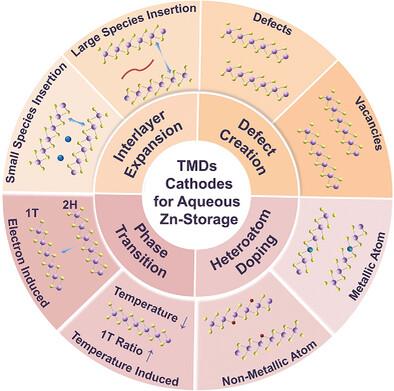Insights on Fabrication Strategies and Energy Storage Mechanisms of Transition Metal Dichalcogenides Cathodes for Aqueous Zn‐Based Batteries
IF 13
2区 材料科学
Q1 CHEMISTRY, MULTIDISCIPLINARY
引用次数: 0
Abstract
Aqueous zinc‐based batteries (AZBs) are gaining widespread attention owing to their intrinsic safety, relatively low electrode potential, and high theoretical capacity. Transition metal dichalcogenides (TMDs) have convenient 2D ion diffusion channels, so they have been identified as promising host materials for AZBs, but face several key challenges such as the narrow interlayer spacing and the lack of in‐deep understanding energy storage mechanisms. This review presents a comprehensive summary and discussion of the intrinsic structure, charge storage mechanisms, and key fabrication strategies of TMD‐based cathodes for AZBs. Firstly, the structural features including phase types and electrical properties of TMDs are underscored. Then, the charge storage mechanisms and activation principles in TMDs are elaborated along with the discussions about their influence on electrochemical performance. Afterward, specific attention is focused on the fabrication strategies of high‐performance TMD cathodes, including interlayer expansion, defect creation, phase transition, and heteroatom doping. Finally, the key challenges are considered and potential effective strategies are proposed to design high‐performance aqueous Zn‐TMDs batteries.

求助全文
约1分钟内获得全文
求助全文
来源期刊

Small
工程技术-材料科学:综合
CiteScore
17.70
自引率
3.80%
发文量
1830
审稿时长
2.1 months
期刊介绍:
Small serves as an exceptional platform for both experimental and theoretical studies in fundamental and applied interdisciplinary research at the nano- and microscale. The journal offers a compelling mix of peer-reviewed Research Articles, Reviews, Perspectives, and Comments.
With a remarkable 2022 Journal Impact Factor of 13.3 (Journal Citation Reports from Clarivate Analytics, 2023), Small remains among the top multidisciplinary journals, covering a wide range of topics at the interface of materials science, chemistry, physics, engineering, medicine, and biology.
Small's readership includes biochemists, biologists, biomedical scientists, chemists, engineers, information technologists, materials scientists, physicists, and theoreticians alike.
 求助内容:
求助内容: 应助结果提醒方式:
应助结果提醒方式:


